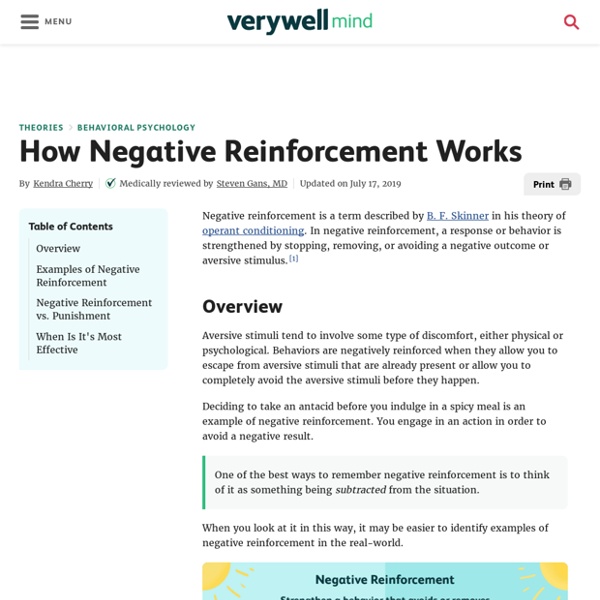Using Positive Reinforcement to Improve Behavior
When your child misbehaves, rewards might be the last thing on your mind. But, positive reinforcement can be one of the most effective behavior modification techniques.1 You can use positive reinforcement to encourage prosocial behaviors, like sharing or following directions. And, you can use it to prevent misbehavior, like hitting and rule violations. Positive reinforcement can also be an effective way to encourage and motivate your child to be responsible, do their chores, get along with their siblings, or complete their homework assignments without arguing. How Positive Reinforcement Works
What Is 'negative Reinforcement'? Definition And Real-World Examples
You've heard of negative reinforcement, but how do you put it into practice? These 4 negative reinforcement examples will explain how. You've probably heard terms like "negative reinforcement" and "positive reinforcement" thrown around a lot during the course of your parenting career. And although the concepts of "reinforcement" and "punishment" are related in that they can influence your child's behavior, they go about it in different ways -- and with different results. [RELATED: "Positive Punishment: Using Consequences to Change Your Child's Behavior"]
Positive Punishment and Operant Conditioning
Positive punishment is a concept used in B.F. Skinner's theory of operant conditioning. How exactly does the positive punishment process work? The goal of any type of punishment is to decrease the behavior that it follows. In the case of positive punishment, it involves presenting an unfavorable outcome or event following an undesirable behavior.
Positive vs Negative Reinforcement: Which Is More Effective?
Table of Content: 1. What is Reinforcement? 2. What are the different types of Reinforcement? 3.
How to Reward Your Teen for Good Behavior
Teenagers are young adults who are trying to learn the ways of the world. When they do something great at school or at home or simply make a healthy decision, parents can give them a reward. The reward does not have to be money, but it is a nice way to say "thank you" or "I'm proud of you."
Reinforcement and Punishment
Learning Objectives Explain the difference between reinforcement and punishment (including positive and negative reinforcement and positive and negative punishment)Define shapingDifferentiate between primary and secondary reinforcers In discussing operant conditioning, we use several everyday words—positive, negative, reinforcement, and punishment—in a specialized manner. In operant conditioning, positive and negative do not mean good and bad. Instead, positive means you are adding something, and negative means you are taking something away. Reinforcement means you are increasing a behavior, and punishment means you are decreasing a behavior.
Positive vs Negative Reinforcement: Which Is More Effective?
The central premise of Pavlok is getting the user to take action and create a new habit — or change an existing one. To do this, we built “pattern interrupts” — jarring but effective stimuli — into the device that encouraged users to change their routines. We then faced a difficult question that’s challenged behavioral psychologists for decades. Which is more effective for behavior change: Negative or positive reinforcement? Positive reinforcement is a reward for doing something well.
Positive Reinforcement and Operant Conditioning
In operant conditioning, positive reinforcement involves the addition of a reinforcing stimulus following a behavior that makes it more likely that the behavior will occur again in the future. When a favorable outcome, event, or reward occurs after an action, that particular response or behavior will be strengthened. One of the easiest ways to remember positive reinforcement is to think of it as something being added. By thinking of it in these terms, you may find it easier to identify real-world examples of positive reinforcement. Sometimes positive reinforcement occurs quite naturally.
12 Examples of Positive Punishment & Negative Reinforcement
You might be thinking that “positive punishment” sounds like an oxymoron, after all, how can punishment be positive? Not many people “like” punishment, right? The disconnect in understanding this concept comes from the usage of the word “positive;” here at PositivePsychology.com, we generally use the term “positive” to refer to things that are inherently good, things that are life-giving, and things that promote thriving and flourishing. The concept of positive punishment comes from a very different era and a very different perspective on psychology; namely, the 1930s and behaviorism. So, what actually is positive punishment and how does it relate to parenting, teaching, and even the workplace?




This is a summary of negative reinforcement and examples of how they can applied to real life situations. by callistael Mar 28
Key Note: Most effective when presented immediately after a behaviour by huiqi Sep 20